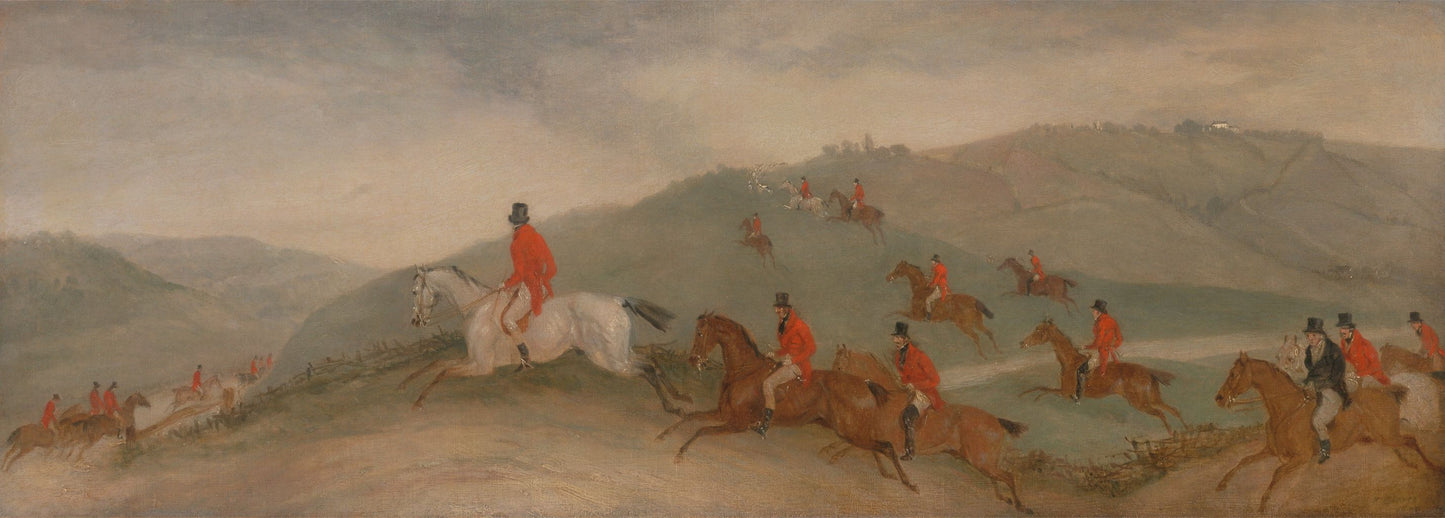Romantic English
Road Riders or Funkers By Richard Barrett Davis RE923324
Road Riders or Funkers By Richard Barrett Davis RE923324
Couldn't load pickup availability
This engaging scene by Richard Barrett Davis, "Foxhunting: Road Riders or Funkers," painted in 1840, delivers a captivating portrayal of the foxhunt—a sport deeply entrenched in British tradition. But unlike many of the action-packed, thrill-seeking moments we often associate with foxhunting, here Davis presents a more subtle, reflective aspect of the hunt: a momentary lull, where the participants, known as funkers—those who shy away from the most challenging parts of the chase—ride along the easier paths, avoiding the more treacherous obstacles.
In the foreground, the most prominent figure sits atop a striking white horse, its muscular form perfectly captured in mid-canter. The rider, dressed in the iconic scarlet coat, stands out not just because of his commanding presence but due to the horse’s almost ethereal whiteness, which contrasts with the earthier tones of the surrounding landscape. His posture is upright, composed, though perhaps betraying the fact that he’s avoiding the more difficult terrain. He leads the group, subtly acknowledging their more cautious approach.
The landscape itself is lush yet muted, with gentle rolling hills that stretch out into the distance. Davis has masterfully rendered the natural undulations of the countryside, with its soft greens and browns, all cloaked under a gentle, misty sky. The hills recede into the background, giving the painting a wonderful sense of depth and space, allowing the viewer to feel the expanse of the hunt unfolding over miles of open land.
To the right of the central figure, a small procession of riders follows behind, their bright red coats providing the only real contrast against the more subdued hues of the hills and sky. The horses, varied in their coats—chestnut, bay, and grey—move with an unhurried pace, their riders clearly at ease, enjoying the scenery as much as the sport. The presence of these funkers, taking the more leisurely path, offers a different perspective on the foxhunt—this is not a frenzied chase but rather a moment to savor the camaraderie of the ride itself.
Further into the background, a smaller pack of riders is seen traversing the more difficult terrain. Some are seen galloping along higher ridges, their horses leaping over hedges with grace and precision. These riders, unlike the road riders in the foreground, are clearly taking the more challenging route, their figures small but dynamic in the distance. The separation between these two groups emphasizes the diversity of experience within the hunt—those who seek the thrill of every leap and jump, and those who prefer a more measured, scenic journey.
The sky above is a soft, atmospheric mix of grey and pale blue, lending a cool, autumnal air to the scene. The clouds are thick but not oppressive, suggesting an overcast day, where the light is diffused, casting a gentle glow over the landscape rather than harsh shadows. It is a perfect hunting day, where the weather serves the purpose of the sport, neither too bright nor too gloomy, but just enough to bring out the earth tones and the reds of the riders' coats in contrast.
Davis has placed particular care in his rendering of the terrain. The grassy fields are detailed with subtle variations in texture, from the rougher, scraggy patches where the hounds are seen to the smoother, well-trodden paths that the funkers traverse. These distinctions serve as visual markers of the differing experiences of the hunt, the more adventurous riders daring the untamed countryside, while others stick to the safer, more predictable roads.
What makes this painting particularly remarkable is the calm dignity of it. There’s no frenetic energy or chaotic rush. Instead, Davis captures a quieter side of the hunt—a reflection on the beauty of the land, the skill of the riders, and the companionship between man and horse. The separation between the funkers and the more daring riders subtly hints at a hierarchy within the hunting tradition, yet Davis treats both groups with equal care, allowing the viewer to appreciate the scene from multiple perspectives.
This is a moment of contemplation, where the sport of foxhunting is not just about the chase, but about the journey itself.
RE923324


